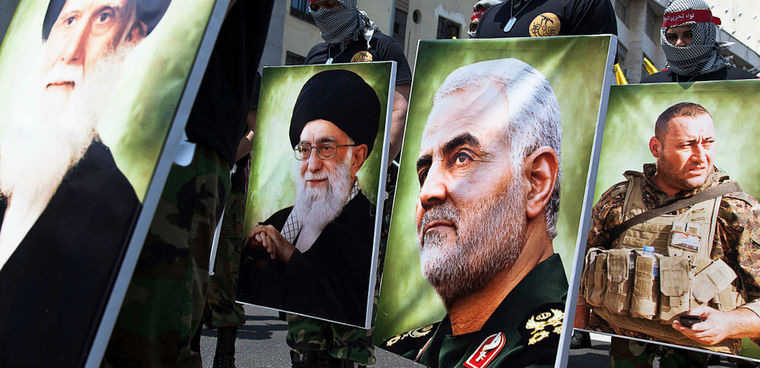
Trump vs. Iran, What’s Next?
On January 2, 2020, the US Pentagon confirmed that the Iranian General Qasem Soleimani was killed in an airstrike carried out by the United States at the direction of President Donald Trump. The exact reasoning for the strike was provided in a statement from the department of defense
At the direction of the President, the U.S. military
has taken decisive defensive action to protect U.S. personnel abroad by killing Qasem Soleimani, the head of the Islamic Revolutionary Guard Corps-Quds Force, a U.S.-designated Foreign Terrorist Organization…
General Soleimani was actively developing plans to attack American diplomats and service members in Iraq and throughout the region. General Soleimani and his Quds Force were responsible for the deaths of hundreds of American and coalition service members and the wounding of thousands more.Statement by the Department of Defense Jan. 2, 2020
This strike was aimed at deterring future Iranian attack plans.
According to the Trump administration, this strike was necessary due to Soleimani planning attacks against American assets and people working in the region. For now, this is all the information that we, the general public have to go off of when analyzing the situation. For some that are less Trump-friendly you may be screaming about credibility and demanding proof, I can’t say you’re wrong for feeling that way, but Nancy Pelosi and Congress are working on it, so we’ll all have to wait our turn. In the meantime, we work with what we have, and we have is a mess.
Let’s be clear about something, Soleimani was a bad guy. He created proxies throughout Iraq and Syria, and those proxies in Iraq turned out to be Shiite militias that he armed and trained. If you’re not familiar with the Shiites, they are not an American friendly group and are responsible for the deaths of an estimated 600 American troops between 2003 and 2011. He was also the driving force behind Iran’s policies to aid and arm Syrian President Bashar al-Assad, which Assad’s track record speaks for itself. So again I say, he was a bad guy, with bad intentions, and his death avenges the lost lives of hundreds of American men and women that died at the wave of his hand. That being said, was it the right move?
There are a number of different ways this could all play out, let’s start with the most extreme, but also the most unlikely. The first scenario is pretty straight forward in the format of an “eye for an eye”. What this would look like is Iran taking out a US senior official of similar rank and capacity. While this is likely high on the Iranian wish list, the probability of such a strike is extremely low, due to the lack of ability to execute. Iran does not have the intelligence capabilities to pull off such a risky maneuver, while the United States has extremely well-developed countermeasures and intelligence to prevent this very thing. For Iran, it sounds good in theory, but in reality, it is a pipe dream. The second scenario is an attack on the United States at home. While Iran has shown proficiency in launching attacks around the middle east, they have not shown such proficiency in being able to do so in Europe or the United States. Much to the same reason why they could not pull off assassinating one of our high ranking officials, it would be just as difficult pulling off an attack in the United States. Again, high on their wish list, but extremely low probability of having success without an extreme stroke of luck.
So what are we (the United States and the world) looking at as the United States and Iran face-off? First of all, remember those Shiite Militias in Iraq we talked about earlier? They will likely be highly motivated to not only push American troops and contractors out of Iraq but take as many lives as possible in doing so. Soleimani enabled them in the region, they will not take his death lightly, therefore all U.S. troops, personnel, and civilians should take security very seriously, and if they don’t need to be there, it is probably a good time to leave.
Could we be looking at a war with Iran in Iraq, putting the Iraqi people in the middle of a mess that has nothing to do with them? This could be the most likely scenario which has terrible implications across the board. First and foremost would be the cost to the Iraqi people who have no dog in this fight and just want their sovereignty. Let’s also not forget about ISIS who is still running around in the shadows, and would see a conflict between the US and Iran in Iraq as an opportunity to re-establish a caliphate out of the chaos that would ensue if Iran and the U.S. go to war in Iraq.
Iran may very well opt to bide its time and wait several weeks, months, or possibly years to attack. They are likely aware of their lack of overall intelligence capabilities causing them to be patient as they continue to develop the necessary skills and tools to be more effective against the United States closer to home. That being said, the proxies created by Soleimani may not be so patient and may lash out much sooner than later. Can the Trump Administration withstand the urge to jump into a major conflict with Iran if the various militias and cells around the Middle East lash out against U.S. assets and installations? How much U.S. restraint is prudent before Trump is left with no other choice but to send mass quantities of troops and weaponry back to the region and likely begin another conflict with no end in sight? Only time will tell, but it’s hard to imagine any of this being resolved peacefully in a timely fashion.
Steve
Steve is an affordable multifamily housing professional that is also the co-founder of Whiskey Congress. Steve has written for national publications such as The National Marijuana News and other outlets as a guest blogger on topics covering sports, politics, and cannabis. Steve loves whiskey, cigars, and uses powerlifting as an outlet to deal with the fact that no one listens to his brilliant ideas.



